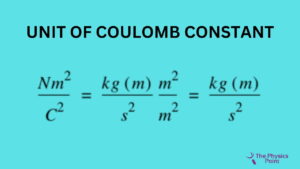What is K in Physics? Meaning, Value and Unit

Hello dear readers, how are you? I hope you all are very fine and enjoying Our article daily. Here we have presented an interesting article on physics that is what is K in Physics. Here we will talk about different types of constants used in Physics subject. but the main focus is on the coulomb constant that is represented by k. Coulomb’s constant is used in the electrostatic branch of Physics. and this constant is universally accepted all over the world. the speed of light is also a Universal constant in every condition and in every place. If you want to know more about coulomb’s law of force and the electrostatic branch of Physics you can check out our previous article posted on our website.
This article what is k in physics is going to be very useful for all the students of board level and also competition level because here we describe many important questions such as the coulomb constant, coulomb’s constant, k physics, k in physics, k constant physics, coulomb’s law equation, coulomb’s law formula, k value in physics, what is k in physics electricity, k unit physics, etc. So please read our whole article from the first paragraph to the end paragraph without skipping it, so that you can understand every concept of this article What is K in Physics very clearly.
What is K in Physics (Meaning)?
There are many types of the constant discovered in Physics. The Coulomb constant is one of them and is represented by K. Most of the constants in physics are written as K. coulomb constant is used in electrostatic physics. In electrostatics, we study the attraction and the repulsion force between the two charged bodies, and in the formula of the force, there is a constant that is called the Coulomb’s constant. The value of this constant is 9×109. In the above we have given you complete information about What is K in Physics.
Derivation of Coulomb’s constant
We can use some methods to derive Coulomb’s constant. Here we will use the four fundamental things that are called the plancks. These plancks are generally Planck length, Planck mass, Planck time, and as well as Planck charge. This can derive in two ways the first one is the Classical constant form and the second one is the wave constant form. The final result of the derivation tools constant is given below in both the form classical constant and the wave constant form. you can understand them with the help of given picture below-

Units
The Coulomb’s law equation is the equation of force and by the energy wave theory, the unit of the coulomb’s constant is N x m2/C2.

What is Coulomb’s law?
Coulomb’s law is the law in the electrostatic branch of Physics. This law of electrostatic tiles is about the basics of attraction and repulsion force between the two charge bodies. the scientist named Charles Augustine De CoulombVery first told about this force of attraction and repulsion between the two charged bodies and he give a mathematical approach to find the force generated by the two chart bodies on each other. In the above we have given you complete information about What is K in Physics.
K Value In Physics
As with k = 9 x 109 Nm2/C2, which was the proportionality constant in Coulomb’s law, km is the “magnetic constant”. In certain ways, the Biot–Savart law for magnetism and Coulomb’s equation for electricity are comparable. It explains the power of electrostatic attraction between charged things. The constant k has the value k = 8.99 × 10 9 N ⋅ m 2 /C in SI units.
How to See the Spring Constant
Consider a play spring. It elongates slightly upon gentle tugging. It extends twice as much when you apply double the force. ‘k’, the proportionality constant, represents this linear relationship between force and displacement. A large value of ‘k’ indicates that even a tiny stretch requires a significant amount of force. The spring is therefore seen as stiff. On the other hand, a spring with a small ‘k’ value is softer and more easily deformed.
But it’s important to realize that not all situations can be explained by Hooke’s law. Materials can permanently deform beyond a certain limit, at which point their response to force becomes nonlinear. For instance, if a rubber band is stretched too far, it won’t shrink back to its initial length and the law won’t apply. In the above we have given you complete information about What is K in Physics.
Types of constants in Physics
Constants in Physics are invariable quantities and these mostly remain constant, which means unchangeable in most conditions so we call them constants. Most of the equations of Physics and formulas contain some types of constants that have a definite value. Some important constants of Physics are used in daily life such that the charge of electrons, as well as the speed of light, etc. We described blow some different types of constants of Physics in detail so please read this article on what is K in physics to understand every concept very clearly.
Planck constant
It is a very important constant of Physics and it is used in quantum mechanics equations. we represent the Planck constant by the symbol h. it is mainly used in the Dual Nature of electron and Photoelectric effect in modern physics. In the above we have given you complete information about What is K in Physics.
Boltzmann constant
This constant is also represented as the representation of the coulomb constant. It means we represent the Boltzmann constant by the letter K. But the value of the Boltzmann constant and the value of the coulomb’s constant is different. The value of this constant i.e. Boltzmann constant is 1.380649×10−23 joule/Kelvin. The main use of this constant is generally for the measurement or calculation of the amount of energy.
Speed of light
The speed of light has a constant value that is equal to 3×108. This speed of light mainly does not very or does not depend on any type of experiment. the value of the speed of light 3×108 is calculated in the vacuum (in the absence of air). it is also called the universal constant of nature. Einstein’s equation of mass energy contains this light constant as E=mc2. In the above we have given you complete information about What is K in Physics.
Frequently Asked Questions
Ques. What is K in Physics?
Ans. K is the coulomb’s constant in Physics.
Ques. What is the value of Coulomb’s constant?
Ans. the value of the Coulomb’s constant in physics is 9×109
Ques. In which formula of Physics coulomb constant is used?
Ans. coulomb’s constant is used in the electrostatic branch of Physics in the formula of Coulomb’s law of force.
Ques. What are some other types of constants in Physics?
Ans. there are different types of constants in physics such as the Planck constant, Redberg constant, speed of light, Universal Gravitational Constant, Thermodynamical constants, etc. These constants have their own value.
Ques. What is Coulomb’s law’s primary application?
Ans. The force between two charged objects or between two charged particles, such as two protons, can be computed using Coulomb’s law. The amount of one electric charge, q1, multiplied by the other, q2, determines the magnitude of the electric force F. The square of the distance between the particles determines the inverse relationship between the two.
Conclusion
The main conclusion of today’s article what is K in Physics is that be available many things about the constants of Physics such as coulomb’s constant the Boltzmann constant, thermodynamical constants, the Planck constant, what is k in physics electricity, k unit physics, what does k mean in physics, what is k physics, k value electric field, etc. So Guys if you have still any queries related to the article you can contact us through the comment section works.
